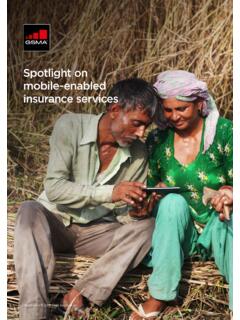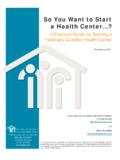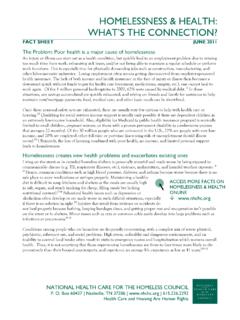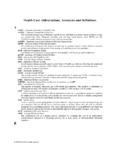Transcription of Health Insurance in India: Rajiv Aarogyasri Health ...
1 IOSR Journal Of Humanities And Social Science (IOSR-JHSS). Volume 8, Issue 1 (Jan. - Feb. 2013), PP 07-14. e-ISSN: 2279-0837, p-ISSN: 2279-0845. Health Insurance in India: Rajiv Aarogyasri Health Insurance Scheme in Andhra Pradesh J. Yellaiah ICSSR Doctoral Fellow, Centre for Economic And Social Studies (CESS), Department of Economics, Osmania University, Hyderabad, Andhra Pradesh. Abstract: Health Insurance as a tool to finance healthcare has very recently gained popularity in India. Government has been putting serious efforts to introduce Health Insurance for the poor in recent years in order to improve access of poor to quality medical care and for providing financial protection against high medical expenses.
2 There have been several attempts to introduce similar schemes in other states but Andhra Pradesh has been one of the only states to successfully roll out the scheme. The Insurance scheme covered lack families out of total across Lack families (87% families covered) residing in 27138 villages 1128. mandals of all districts of the State in five Phases. The scheme started with 330 procedures covered and has been gradually extended to 938 procedures. The majority of beneficiaries utilizing the scheme are illiterate and have a rural address.
3 Since inception of the scheme ( ) till 18th January 2013- 35713 Medical camps were held by the network hospitals in rural areas. Total Surgeries/Therapies done by under this scheme is 1753466, Government is 440655 and Private is 1312811. Key words: Health Insurance , Aarogyasri Health Insurance scheme, Community Health Insurance , Healthcare, Healthcare Expenditure. I. Introduction: Health is an important constituent of human resource development. Good Health is real wealth of society. It not only increases human efficiency but also decreases private and public expenditure on sickness and diseases.
4 Health has been declared as a fundamental human right. Healthcare services help to reduce infant mortality rate, check crude death rate, keep diseases under control and raise life expectancy. World development report 1993 stated, Improved Health contributes to economic growth in four ways: It reduces production losses caused by worker illness, it permits the use of natural resources that had been totally or nearly increasable because of disease, it increases the enrolment of children in schools and makes them better able to learn, and it frees for alternative uses resources that would otherwise have to be spent on treating illness.
5 The economic gains are relatively greater for poor people, who are typically most handicapped by ill Health and who stand to gain the most from the development of underutilized resources.. Various studies examine effect of Out-Of-Pocket (OOP) Health expenditure on poverty head count and whether such expenses push households deeper into poverty. Adversities related to out-of-pocket spending are apparent in the form of intensified poverty and ill fare in the country. For instance, in 1995-96 an estimated of the Indian population fell into poverty because of out-of-pocket spending (Peters et al 2002) and it increased to around in 1999-2000 (Garg and Karan 2009).
6 A significant proportion of population may have had to sell their assets (productive) for inpatient care (Peters et al. 2002; Dilip and Duggal 2002). A. significant proportion of population may have had to forgo treatment all together due to scarcity financial resources (NSSO, 60th Round, 2004). Health Insurance can provide financial protection to households in the event of Health shock and can reduce catastrophic out-of-pocket expenditure on Health care (Joglekar, 2009). So that it can protect families from impoverishment and empower the patient to seek Health care as a right (Gilson, 1998).
7 In developing and low income countries Health care finance is still predominantly based on out-of- pocket (OOP) payments, and the lack of prepayment mechanisms like Insurance . In the absence of Insurance , an illness not only reduces welfare directly, it also increases the risk of impoverishment due to high treatment expenditures (Wagstaff, A and E. van Doorslaer, 2003). Objectives of the study: 1. To discuss the coverage and features of major Health Insurance schemes in India. 2. To examine the role of state Health Insurance scheme (Rajeev Aarogya Sri) in Andhra Pradesh.
8 7 | Page Health Insurance In India: Rajiv Aarogyasri Health Insurance Scheme In Andhra Pradesh II. Methodology: The data collected from secondary sources such as scheme website, available assessment reports, and the data provided by the Aarogya sri Health care trust, Scheme website and published articles. Health Insurance Coverage in India The current trends in the Health Insurance coverage indicate a quantum leap, especially since the last three years, mainly because of the implementation of the Health Insurance schemes such as Rashtriya Swasthya Bima Yojana (2008), Rajiv Arogyasri scheme (2007), Kalingar (2009) and Vajapayee Arogyasri scheme (2009).
9 In India, in the year 2009-10 all forms of Insurance both Government and non-government together covered approximately 302 million individuals or 25 percent of India s population in 2010 (Table 1). And of this nearly 82 percent are covered by government schemes. Table 1: Scheme-wise Health Insurance Coverage Total covered population in 2009-10 (in millions). Sl. Unit of Percentage Scheme Covering No. of No. of Percentage No Enrolment of Total Group Families beneficiaries of Total (GSS). Central Govt. 1 CGHS (1954) Family Employees All the 2 ESIS (1952) Family Employees Rashtriya Swasthya 3 BPL families Family Bima Yojana (2008).
10 Rajiv Arogyasri 4 BPL families Family 70 (2007). Kalaignar 5 BPL families Family 35 (TN) (2009). Vajapayee Arogyasri 6 BPL families Family scheme (KN). (2009). Yeshasvini 7 APL & BPL Individual N/A (KN) (2003). Total Government Sponsored Schemes (GSS) 247 100 Private 8 Health Voluntary Individual N/A 55 Insurance Grand Total 302 100. * Estimate; N/A Not Applicable; 1No. of Beneficiaries = No. of families (card holders). Source: A Critical assessment of the Existing Health Insurance models in India. Report submitted by Public Health Foundation of India It may be observed that a substantial portion is covered (32 %) through Rashtriya Swasthya Bima Yojana (RSBY), followed by the state of Andhra Pradesh with has covered of the total beneficiaries through Rajiv Aarogyasri scheme.
















